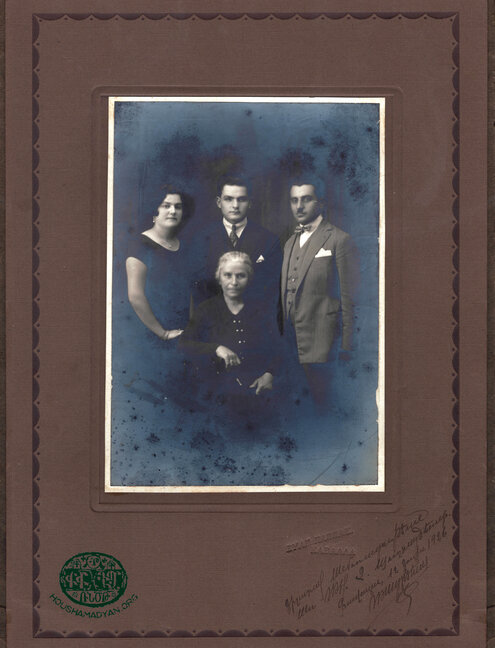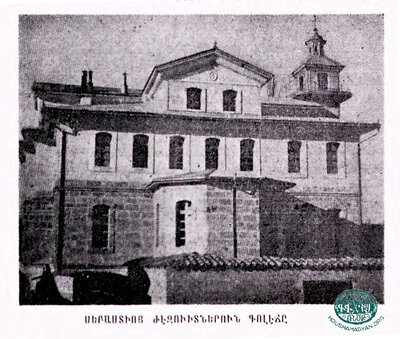Bledjian Collection - Thessaloniki
Translator: Simon Beugekian, 10/12/21 (Last modified 10/12/21)
The memory objects and materials presented on this page were collected and catalogued during Houshamadyan’s workshops in Thessaloniki on November 13 and 14, 2021.
This page was prepared collaboratively with the “Armenika” periodical of Athens and the Thessaloniki chapter of the Hamazkayin Cultural Association. Houshamadyan’s workshops were made possible thanks to the support of EVZ Foundation, Germany.

These materials, which tell the history of Bledjian family, were provided to us by Dickran Bledjian. Dickran’s paternal great-grandfather was Serop Bledjian, who lived in Sepasdia/Sivas. Serop was married to Shamouel Daghavarian (1864-1933). The couple had two children, Dikran (born in 1885) and Hagop (born in 1888). Serop’s oldest son, Dikran, was the grandfather of the Dickran Bledjian who provided us these materials.
Serop and Shamouel’s youngest son, Hagop, died in 1912, while serving in the Ottoman army. As for Dikran Bledjian, we know that he attended the Jesuit’s College of the Forty Martyrs (Collège des Quarante Martyrs), a secondary school in Sepasdia/Sivas. This educational institution was founded in the early 1880s. Most of its teachers were Armenian, and the principal language of instruction was Armenian. At its heyday, the school had an enrollment of approximately 500 pupils, of whom about 20 were Greek Orthodox, and the rest were Armenian. After graduating from this school, Dikran worked there as a teacher for some time.
Dikran then moved to Smyrna and began working in the tobacco industry. He sent for his mother, Shamouel (or Shamo), to join him there. During the years of the Genocide, Dikran served in the Ottoman army while his family and relatives, back in Sepasdia/Sivas, were deported and killed. Only a few survived, including Hovhannes Bledjian, Dikran’s cousin.

After the Armistice of 1918, Dikran left Smyrna and settled down in Constantinople. He was able to send for Shamouel and Hovhannes to join him. In the capital, Dikran came across the Missirian Brothers, who were engaged in the tobacco trade. Dikran began working with them, and a little while later, in 1923, he and his family left Constantinople and settled in the city of Kavala in Greece, where they launched a tobacco farming and distribution company. Dikran’s mother and Hovhannes also settled down in Kavala.
In Kavala, Dikran married Nectar, and they had three children: Nourhan, Irma, and Alice. Throughout Dikran’s career with the Missirian company, his closest colleague was Hagop Boghdadjian. They both had the rank of manager. We assume that Hagop Boghdadjian was a former resident of Smyrna, and that the close friendship between the two men dated from the years they spent there. Hagop and his wife, Zabel, had two children, Alice and Karekin. Dikran’s son, Nourhan, moved to the United States in the 1960s, where he became an expert in the tobacco industry. Eventually, Nourhan moved back to Kavala, and a short time later, to Thessaloniki. There, he married Vehanoush Kalfayan, who was Hagop Boghdadjian’s granddaughter (Alice’s daughter). The wedding ceremony was held in the Armenian church of Kavala. The new family settled down permanently in Thessaloniki, where Vehanoush gave birth to the couple’s two children, Dickran (who provided these materials to Houshamadyan) and Nectar.
The Missirian tobacco factory is the only enterprise of its kind that continues to operate to this day in Kavala.


Sivas/Sepasdia. The Bledjian family. Standing, in the back, is Dikran Bledjian. Hovhannes Bledjian is sitting on the lap of Dikran’s father (name unknown). The names of the other members of the family are unknown.

Three soldiers serving in the Ottoman Army. Seated, on the left, is Dikran Bledjian. The inscription on the back of the photograph states that it was taken in Pendik, which today is a neighborhood of the city of Istanbul. Dikran was most probably stationed there during his service. This photograph was sent to his mother, Shamouel, and was dated October 22, 1917.


1. Hagop Boghdadjian, photographed in Smyrna in 1919. He was Vehanoush Bledjian’s (nee Kalfayan) maternal grandfather. Hagop was Dikran Bledjian’s colleague at the Missirian tobacco factory in Kavala. This photograph was a gift to Dikran Bledjian. The inscription is dated January 1, 1919.
2. Kavala, 1926. Family photograph. Standing, left to right: Nectar, Hovhannes, and Dikran. Seated, Shamouel Bledjian (nee Daghavarian).
Prayer rug, Sivas/Sepasdia. Weaved with silk thread. Size: 158 × 112 cm. (62 × 44 in.). The rug belonged to the Bledjian family. At the family home in Sepasdia/Sivas, it covered the floor of a special prayer room. Serop Bledjian would cloister himself in that room to pray. Judging by the patterns on the rug, it was very likely the work of one of Sepasdia’s Armenian masters.

Talas. December 17, 1908. On this day, the Ottoman Parliament (Meclis-i Mebusan) reconvened in Constantinople. This was an important historical event that followed the reinstatement of the Ottoman Constitution. As the photograph shows, the Armenian population of Talas celebrated the occasion with great pomp. This group photograph was probably taken outside one of the Armenian churches of the city. It features prominent personalities, musicians, and students; and slogans supporting the constitutional reforms, in Turkish and Armenian. The photograph also features Madteos Kalfayan, Vehanoush Kalfayan’s grandfather. Vehanoush would later marry Nourhan Bledjian (Dikran Bledjian’s son) in Kavala. Madteos Kalfayan fell victim to the Armenian Genocide.

Nourhan Bledjian’s first-grade certificate, validated by the authorities. The certificate states that nine-year-old Nourhan successfully completed the 1937-1938 school year in the co-educational Armenian school of Kavala. The certificate is dated July 18, 1939, and bears the school’s official stamp. Notably, the certificate mentions that Nourhan’s father was engaged in the tobacco trade and was an "alodapos", or foreigner.


1. Dikran Bledjian with his colleagues at the Missirian tobacco factory, 1960s. Bledjian is slightly to the right of center, sniffing tobacco leaves.
2. Dikran Bledjian and his colleagues at the Missirian tobacco factory, 1960s. Bledjian is in the front row, slightly to the right of center, his arm stretched out.


Some photos from the workshop in Thessaloniki




















